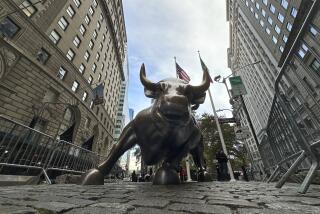Dow Dives a Record 108 Points : Frenzied Trading Results in 4.6% Loss for Market
NEW YORK — Stocks plunged Friday as the Dow Jones industrial average dropped 108 points in record volume, its biggest slide ever and the first time it has shed more than 100 points in a single day.
“The market is in a capitulation stage,” said Dennis Jarrett, analyst at Kidder, Peabody & Co. “We saw across-the-board selling.”
Large institutions and small retail accounts were sellers. Mutual fund redemptions contributed to the selling fervor, and computerized program selling gave it added fuel.
The Dow Jones industrial average plunged 108.35 to 2246.74, surpassing a record loss of 95.46 points on Oct. 14.
Less Than 1929 Plunge
In percentage terms, the Dow fell about 4.6% Friday and 9.5% for the week. That is less than the index’s 12.9% plunge on Oct. 28, 1929.
The Dow Jones average of 30 blue chips plunged 108.36 to 2,246.73, setting a point-loss record for the third time in the last nine sessions.
In less than two months since it established a record closing high of 2,722.42 on Aug. 25, the Dow has fallen 475.69 points, or 17.47%.
That stands as the worst setback the market has encountered since prices began their historic rise in August, 1982. But it has not yet come anywhere near the approximately 45% drop in the Dow that occurred in the big bear market of 1973-74.
Friday’s volume on the New York Stock Exchange hit 338.48 million shares, eclipsing the previous high of 302.39 million set last Jan. 23.
Since reaching a high of 2722.42 Aug. 25, the Dow index of 30 large, heavily capitalized companies has lost 17.5% of its value.
‘It’s Just Unreal’
“My guts are numb,” said Trude Latimer, analyst at Josephthal & Co. “It’s unreal; it’s just unreal.”
Broad-market indexes posted big losses. The New York Stock Exchange index fell 8.32 to 159.13. Standard & Poor’s 500-stock index dropped 15.38 to 282.70. The price of an average share plunged $1.88.
On the Big Board, where record-setting volume totaled 338.5 million, losing issues led gainers, 1,746 to 101, among the 2,045 issues traded.
Prices plunged in heavy trading of over-the-counter and American Stock Exchange issues. The American Stock Exchange index plummeted 12.25 to 323.55 while the National Assn. of Securities Dealers composite index dropped 16.18 to 406.33.
Traders said bearish sentiment that has been gathering on Wall Street in recent weeks snowballed into an avalanche of selling.
Stocks were lower after a blue-chip rally faded in the first half-hour of trading and stocks came under more pressure when bonds erased gains held for much of the session. The Dow dipped below 2300 about two-thirds of the way through the session. It bounced briefly, then headed lower again. Minutes before the close, the widely followed barometer was down nearly 130 points.
“The market’s just not ready to go up yet,” said Rodd Anderson, vice president in equity trading at Shearson Lehman Bros.
“After such a steep correction, it’s awfully tempting to step in and buy,” Anderson said, “but we’ll just have to see. We could get another day of this, and my buy tickets are still firmly on my desk. I haven’t picked up one yet.”
Merrill Lynch & Co. said its investment strategists raised the bond portion of their model portfolio to 40% of assets from 35% and lowered the stock portion to 40% from 45%. Twenty percent of the model portfolio’s assets remain in cash.
Rising Interest Rates
Merrill’s chief investment strategist, Charles Clough, said the trade deficit news that has triggered the financial markets’ recent declines were “just the catalyst.”
Analysts attribute the market’s retreat to building inflation fears and rising interest rates stimulated by the stronger economy and weak dollar.
Despite steep, pervasive losses, Jarrett said his firm does not believe the bull market is over.
“A lot of damage has been done, but this is the type of action you need to wash out and cleanse the system,” Jarrett said. “We think the bull market is very much in place and that we will see new highs on the Dow in three to six months.”
Six months from now, he said, an investor could be saying, “Gee, why didn’t I buy IBM at 135 or General Motors at 66?”
On the trading floor, AT&T; was the most active NYSE-listed issue, falling 2 1/8 to 30.
Exxon followed, falling 3 to 43 3/4.
International Business Machines was third, dropping 5 1/8 to 135.
Among other blue chips, Eastman Kodak fell 2 7/8 to 90 1/8, American Express slid 3 to 30 1/2, General Electric slid 3 to 50 3/4 and General Motors lost 3 7/8 to 67.
Factors in of Volume
Volume of NYSE-listed issues including trades in stocks on regional exchanges and in the over-the-counter market at 4 p.m. EDT totaled 360,265,168 shares, compared with 288,620,300 in the previous session.
Losers overwhelmed gainers 722-80 among the 964 issues traded on the Amex where 18,450,000 shares traded, compared to 12,870,000 traded Thursday.
Amdahl led the Amex actives, falling 3 to 43 1/2.
More to Read
Inside the business of entertainment
The Wide Shot brings you news, analysis and insights on everything from streaming wars to production — and what it all means for the future.
You may occasionally receive promotional content from the Los Angeles Times.










